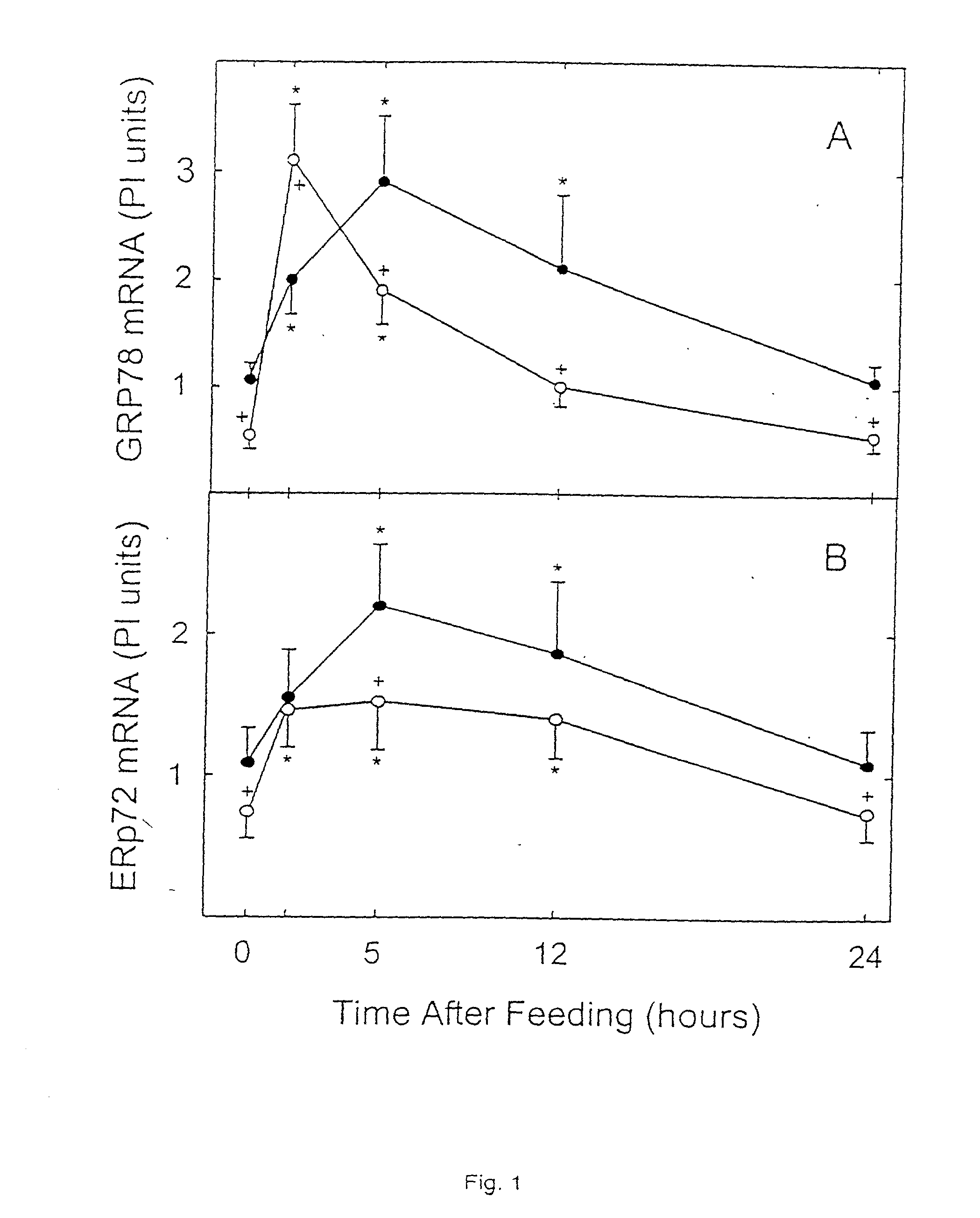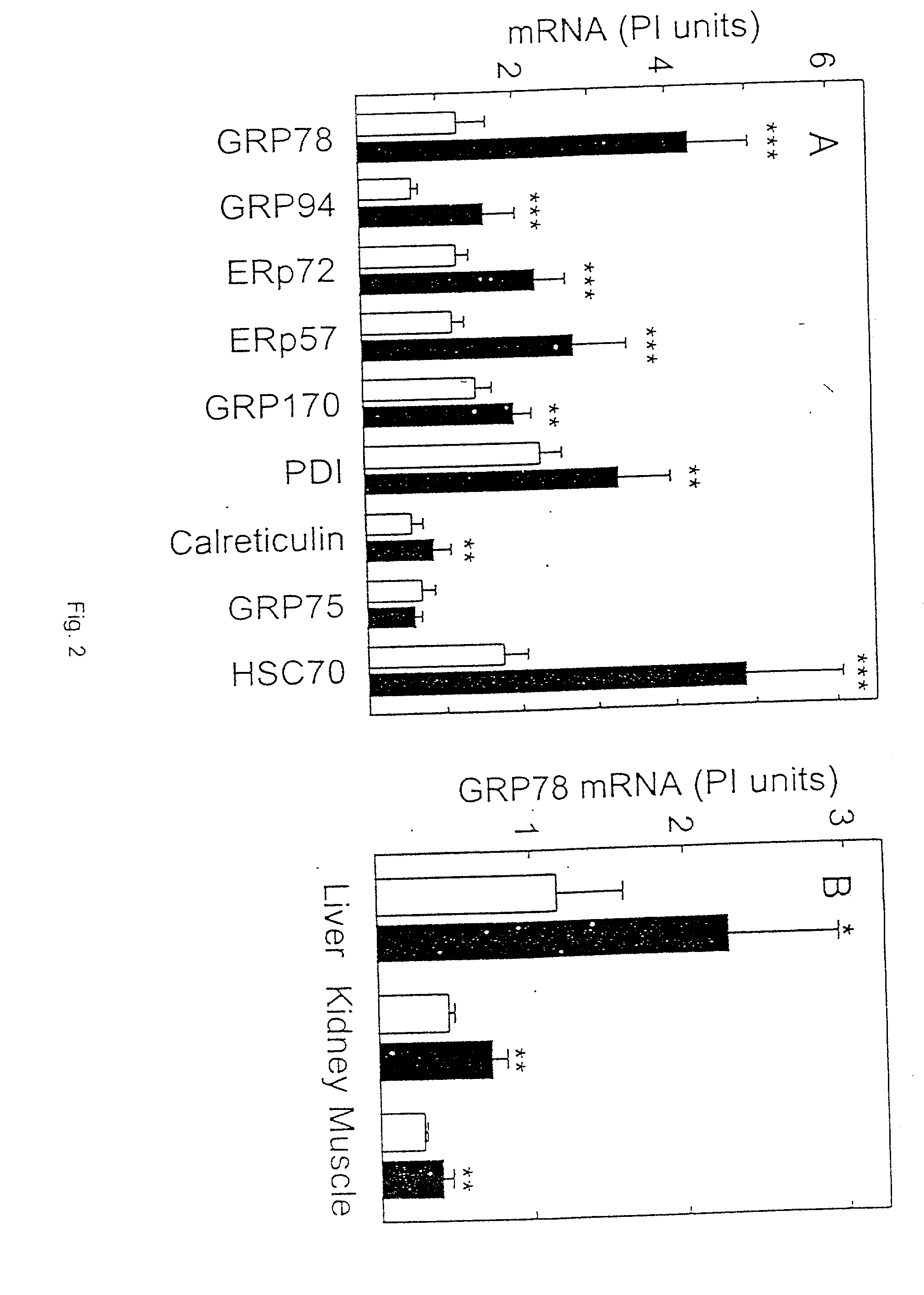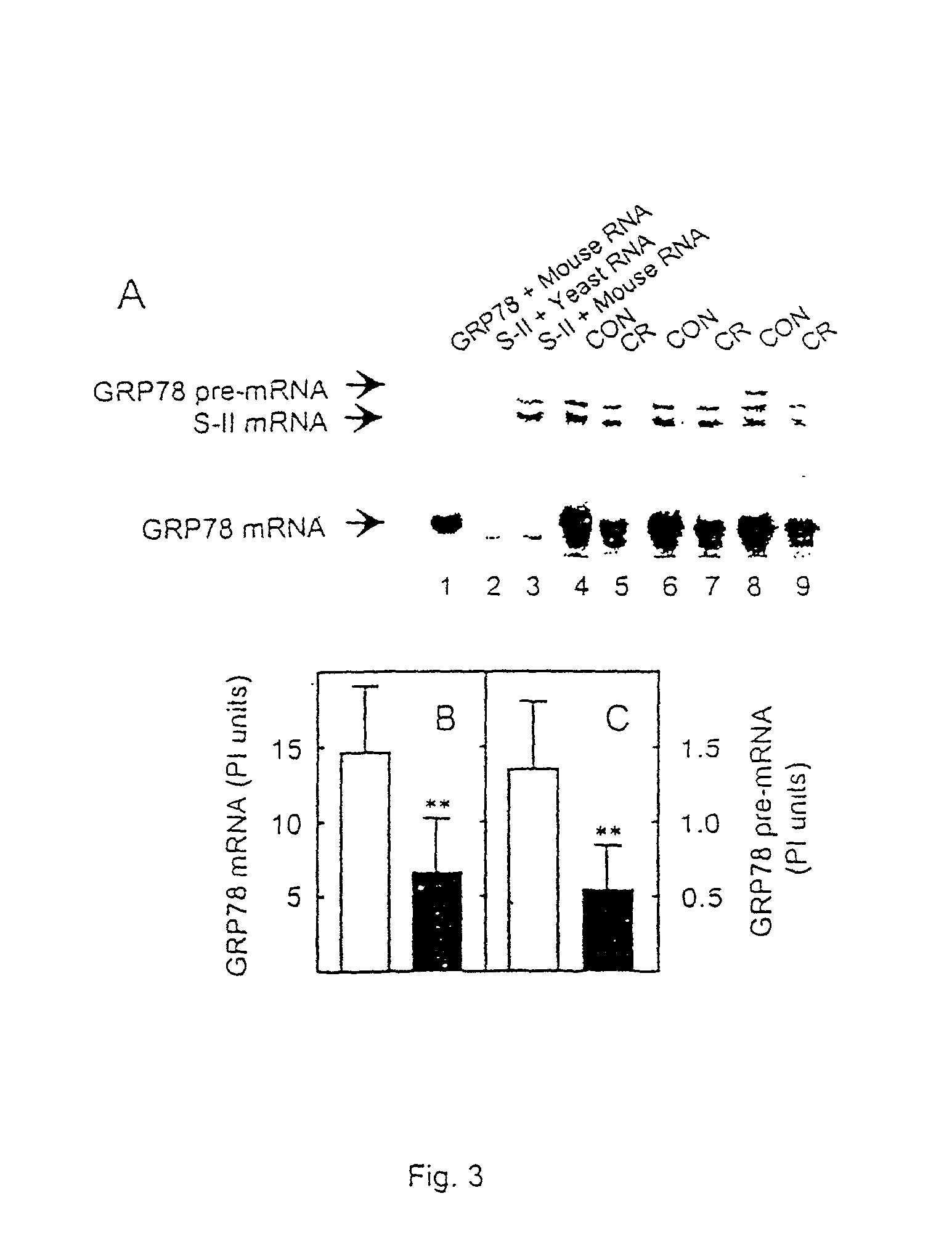Interventions to mimic the effects of calorie restriction
a technology of intervention and calorie restriction, applied in the field of interventions to mimic the effects of calorie restriction, can solve the problems of inability to know at present whether the differences in life spans are different, and no studies on the effects of short-term calorie restriction on metabolism and gene expression, and achieve the effects of reducing the rate of grp78 gene transcription or the stability of grp78 primary transcripts, affecting the response kinetics, and less in the cr
- Summary
- Abstract
- Description
- Claims
- Application Information
AI Technical Summary
Benefits of technology
Problems solved by technology
Method used
Image
Examples
example 1
Long Term Calorie Restricted (LTCR) Animals and Treatments for Chaperone Studies
[0069] Female, 28 month old mice of the long lived F, hybrid strain C3B10RF.sub.1 have been described previously. Mice were weaned at 28 d, housed individually and subjected to one of two diets. The control diet consisted of casein (high protein), 207.0 g / kg, DL-methionine, 4.0 g / kg, dextrose monohydrate, 301.8 g / kg, corn starch, 290.0 g / kg, cellulose, 702. g / kg, brewer's yeast, 8.0 g / kg, Harlan Teklad Vitamin Mix #40060, 10.0 g / kg, Harlan Teklad AIN-76 Mineral Mix #170915, 35.0 g / kg, calcium carbonate (CaCO.sub.3), 3.0 g / kg, magnesium oxide (MgO), 1.0 g / kg, sodium fluoride (NaF), 2.3 mg / kg, sodium molybdate (Na2MoO.2H.sub.2O), 0.5 mg / kg. The 50% restricted diet consisted of casein (high protein), 362.0 g / kg, DL-methionine, 7.0.sup.- g / kg, dextrose monohydrate, 172.03 g / kg, corn starch, 153.1 g / kg, cellulose, 83.6 g / kg, brewer's yeast, 14.0 g / kg, Harlan Teklad Vitamin Mix #40060, 17.5 g / kg, harlan Teklad...
example 2
RNA Isolation and Quantification for Chaperone Studies
[0071] Mice were killed and the livers, kidneys, and muscle were removed. Muscle from the hind legs and back was removed and pooled for each animal. Tissues were flash frozen in liquid nitrogen. Approximately 0.2 g of frozen tissue was homogenized for 40 s in 4 ml of TRI Reagent (Molecular Research Center, Cincinnati, Ohio) using a Tekmar Tissuemizer (Tekmar, Cincinnati, Ohio) at a setting of 55. RNA was isolated as described by the TRI Reagent supplier. RNA was resuspended in FORMAzol (Molecular Research Center) and Northern and dot blots were performed using 20 and 10 .mu.g of RNA respectively. The RNA was analyzed using Northern blots to verify its integrity. Dot blots were used to quantify mRNA levels (24; 27). Specific mRNA levels were normalized to the level of total RNA and / or mRNA present in each sample using hybridization with radiolabeled complementary DNA to 18S rRNA and / or transcription factor S-II, as indicated in th...
example 3
RNase Protection Assays for Chaperone Studies
[0072] A 223 base pair (bp) DNA fragment made up of 110 bases of intron 3 and all 113 bases of exon 4 of the mouse GRP78 gene was synthesized by PCR using genomic DNA as template and inserted into pT7 / T3 (Ambion, Austin, Tex.). Two probes of the junction region of intron 7 and exon 7 of the GRP78 gene were produced by PCR using mouse genomic DNA as template. A 257-base fragment including all of exon 7 and the first 113 bases of intron 7 was produced. A 200-base fragment including all of exon 7 and the first 56 bases of intron 7 also was produced. The T7 RNA polymerase promoter was ligated to these PCR fragments using a Lig'nScribe kit as described by the supplier (Ambion). These constructs were used as template for the synthesis of [.sup.32P] labeled antisense RNA probes using a MAXIScript kit as described by the supplier (Ambion). RNase protection assays were performed using an RPA II kit as described by the supplier (Ambion). Hybridizat...
PUM
| Property | Measurement | Unit |
|---|---|---|
| time | aaaaa | aaaaa |
| time | aaaaa | aaaaa |
| time | aaaaa | aaaaa |
Abstract
Description
Claims
Application Information
 Login to View More
Login to View More - R&D
- Intellectual Property
- Life Sciences
- Materials
- Tech Scout
- Unparalleled Data Quality
- Higher Quality Content
- 60% Fewer Hallucinations
Browse by: Latest US Patents, China's latest patents, Technical Efficacy Thesaurus, Application Domain, Technology Topic, Popular Technical Reports.
© 2025 PatSnap. All rights reserved.Legal|Privacy policy|Modern Slavery Act Transparency Statement|Sitemap|About US| Contact US: help@patsnap.com



